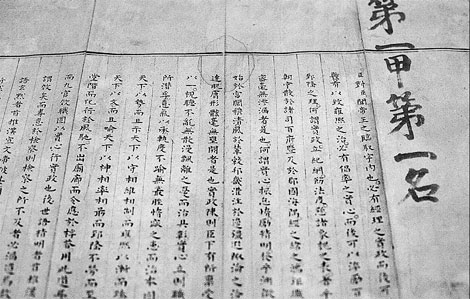|
 |
|
The Ming Dynasty scholar's scroll is still very well-kept and in fine condition. Ju Chuanjiang / China Daily |
In ancient China, civil servants were chosen by an exacting exam system that allowed even the poorest scholars a chance at fame and glory. At the Shandong Qingzhou Museum, a scroll tells that story. Wang Qian and Ju Chuanjiang report.
This was an examination paper - one submitted more than 400 years ago by a candidate in the imperial examinations, the keju, a system that has served the Chinese dynastic courts well for at least 13 centuries.
Remarkably, it is still in fine condition, and the print is as clear as the day it was written, when Zhao Bingzhong sat for the final test in the presence of the emperor himself in 1598.
Zhao became the top scholar that year, at 25, and won the title of zhuangyuan (状元). He was appointed minister of rites, which translates to minister of culture or education in today's terms.
There have only been 777 top scholars chosen from the imperial examinations since they were inaugurated, from the thousands who had been gradually short-listed from local to regional to provincial levels.
This system of recruiting the top talents from the country lasted more than 1,300 years from its founding during the Sui Dynasty (AD 581-618) to its abolition in the late Qing Dynasty (1644-1911).
It was open to people of all ages and held every three years.
The qualifying rounds were at three levels, with provincial, national and Palace examinations. Only those who passed all the lower levels were eligible to sit before the emperor for the final and deciding test.
Every successful candidate would get an official post, and the top scorer would be granted the title of zhuangyuan, and endowed with rank and wealth.
Often, if the scholar was still single, the emperor would marry one of his princesses to the eligible bachelor.
At the Qingzhou Museum in Shandong province, Zhao Bingzhong's winning paper is one of the museum's most prominent exhibits.
"The paper is arguably the only zhuangyuan paper from the Ming Dynasty (1368-1644) or before that has been discovered in China. Only a few from the later Qing Dynasty had been collected at the Taipei Palace Museum," says Wang Ruixia, the deputy curator of the Qingzhou Museum.
"It was rated a first-class national treasure by experts of the Palace Museum in Beijing, as it provides unique and precious records of the Chinese imperial exam system and our cultural heritage."
The paper, set in an accordion-fold book, is protected by an exquisite cover of damask silk.
Made from three layers of rice paper, the book is about 330 centimeters long and 38 cm wide when fully extended.
The first part, a brief introduction of the candidate and the three generations of his family, is sealed to prevent tampering and fraud.
The main body contains 90 vertical rows and 2,460 words written in xiaokai (small script), the scholar's dissertation, a profound and philosophical discourse on outdated management strategy and current affairs.
It was executed in superb brushwork without any spelling mistakes or modification.
Zhao's paper captured the emperor's attention and admiration, and he marked "the best of best" in red ink on the paper, thus confirming the top scholar's destiny.
The winning papers were normally kept closely guarded in imperial courts, as state secrets, and anyone who moved them without permission could be punished by death.
Nearly all were destroyed or lost as a result of dynastic changes, war or turbulence, and there are many versions on why Zhang's paper managed to survive.
Some experts believe that Zhang stole his paper from the palace when he was minister of rites in charge of the imperial examinations, so his descendants would have a record of his glory days.
Another story says Zhao suffered persecution in the whirlwind of court politics.
Depressed, he tried to steal his paper and asked to leave his post for fear that he would be trapped by his political enemies because of the ideas he had expressed.
Zhao's descendants did not let him down. They carefully kept his examination paper for nearly 400 years until Zhao Huanbin, his 13th-generation descendant, donated it to the Qingzhou Museum in 1983.
"I used to hide it in my pillow and never show it to anybody," Zhao Huanbin recalled. Eight years later, it was nearly lost again.
In 1991, a security guard named Lin Chuntao who worked in the museum managed to steal the paper and tried to sell it to an antiques dealer for 1.5 million yuan ($236,400).
Fortunately, Lin was caught before the deal was made. Since then, the paper has been kept in vaults and seldom displayed.
You may contact the writers at sundayed@chinadaily.com.cn.
By Wang Qian and Ju Chuanjiang (China Daily)
(China Daily 03/18/2012 page15) |